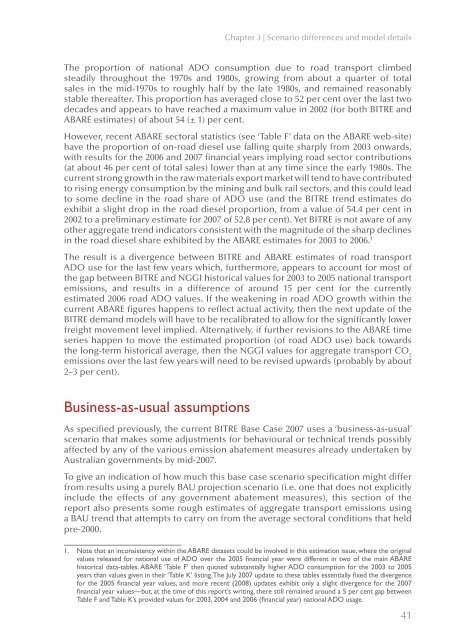PDF: 9795 KB - Bureau of Infrastructure, Transport and Regional ...
PDF: 9795 KB - Bureau of Infrastructure, Transport and Regional ...
PDF: 9795 KB - Bureau of Infrastructure, Transport and Regional ...
You also want an ePaper? Increase the reach of your titles
YUMPU automatically turns print PDFs into web optimized ePapers that Google loves.
Chapter 3 | Scenario differences <strong>and</strong> model details<br />
The proportion <strong>of</strong> national ADO consumption due to road transport climbed<br />
steadily throughout the 1970s <strong>and</strong> 1980s, growing from about a quarter <strong>of</strong> total<br />
sales in the mid-1970s to roughly half by the late 1980s, <strong>and</strong> remained reasonably<br />
stable thereafter. This proportion has averaged close to 52 per cent over the last two<br />
decades <strong>and</strong> appears to have reached a maximum value in 2002 (for both BITRE <strong>and</strong><br />
ABARE estimates) <strong>of</strong> about 54 (± 1) per cent.<br />
However, recent ABARE sectoral statistics (see ‘Table F’ data on the ABARE web-site)<br />
have the proportion <strong>of</strong> on-road diesel use falling quite sharply from 2003 onwards,<br />
with results for the 2006 <strong>and</strong> 2007 financial years implying road sector contributions<br />
(at about 46 per cent <strong>of</strong> total sales) lower than at any time since the early 1980s. The<br />
current strong growth in the raw materials export market will tend to have contributed<br />
to rising energy consumption by the mining <strong>and</strong> bulk rail sectors, <strong>and</strong> this could lead<br />
to some decline in the road share <strong>of</strong> ADO use (<strong>and</strong> the BITRE trend estimates do<br />
exhibit a slight drop in the road diesel proportion, from a value <strong>of</strong> 54.4 per cent in<br />
2002 to a preliminary estimate for 2007 <strong>of</strong> 52.8 per cent). Yet BITRE is not aware <strong>of</strong> any<br />
other aggregate trend indicators consistent with the magnitude <strong>of</strong> the sharp declines<br />
in the road diesel share exhibited by the ABARE estimates for 2003 to 2006. 1<br />
The result is a divergence between BITRE <strong>and</strong> ABARE estimates <strong>of</strong> road transport<br />
ADO use for the last few years which, furthermore, appears to account for most <strong>of</strong><br />
the gap between BITRE <strong>and</strong> NGGI historical values for 2003 to 2005 national transport<br />
emissions, <strong>and</strong> results in a difference <strong>of</strong> around 15 per cent for the currently<br />
estimated 2006 road ADO values. If the weakening in road ADO growth within the<br />
current ABARE figures happens to reflect actual activity, then the next update <strong>of</strong> the<br />
BITRE dem<strong>and</strong> models will have to be recalibrated to allow for the significantly lower<br />
freight movement level implied. Alternatively, if further revisions to the ABARE time<br />
series happen to move the estimated proportion (<strong>of</strong> road ADO use) back towards<br />
the long-term historical average, then the NGGI values for aggregate transport CO 2<br />
emissions over the last few years will need to be revised upwards (probably by about<br />
2–3 per cent).<br />
Business-as-usual assumptions<br />
As specified previously, the current BITRE Base Case 2007 uses a ‘business-as-usual’<br />
scenario that makes some adjustments for behavioural or technical trends possibly<br />
affected by any <strong>of</strong> the various emission abatement measures already undertaken by<br />
Australian governments by mid-2007.<br />
To give an indication <strong>of</strong> how much this base case scenario specification might differ<br />
from results using a purely BAU projection scenario (i.e. one that does not explicitly<br />
include the effects <strong>of</strong> any government abatement measures), this section <strong>of</strong> the<br />
report also presents some rough estimates <strong>of</strong> aggregate transport emissions using<br />
a BAU trend that attempts to carry on from the average sectoral conditions that held<br />
pre-2000.<br />
1. Note that an inconsistency within the ABARE datasets could be involved in this estimation issue, where the original<br />
values released for national use <strong>of</strong> ADO over the 2005 financial year were different in two <strong>of</strong> the main ABARE<br />
historical data-tables. ABARE ‘Table F’ then quoted substantially higher ADO consumption for the 2003 to 2005<br />
years than values given in their ‘Table K’ listing. The July 2007 update to these tables essentially fixed the divergence<br />
for the 2005 financial year values, <strong>and</strong> more recent (2008) updates exhibit only a slight divergence for the 2007<br />
financial year values—but, at the time <strong>of</strong> this report’s writing, there still remained around a 5 per cent gap between<br />
Table F <strong>and</strong> Table K’s provided values for 2003, 2004 <strong>and</strong> 2006 (financial year) national ADO usage.<br />
41

















